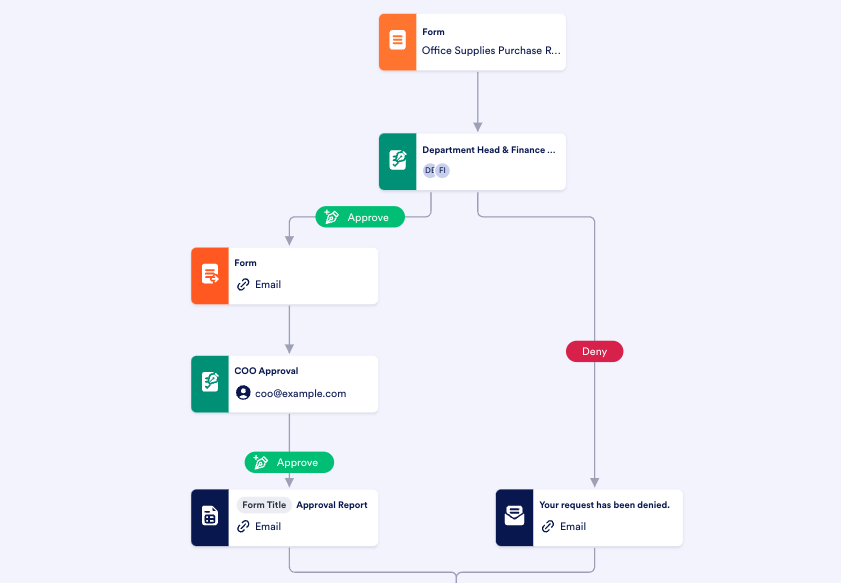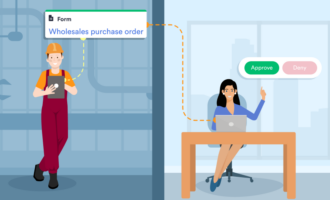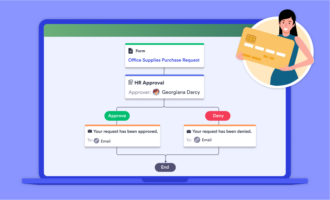Types of purchase orders
- Standard purchase order (PO)
- Planned purchase order (PPO)
- Blanket purchase order (BPO)
- Contract purchase orders (CPO)
If your business works with vendors — and almost all businesses do — the success of your collaboration depends on your industry knowledge.
One way to boost your vendor know-how is to familiarize yourself with the four types of purchase orders, which all have their place in typical business accounting. The four differ in meaningful ways, and understanding those differences takes time and patience.
Apart from developing an understanding of the types of purchase orders, you should also optimize your order approval process. Manually approving any type of purchase order is resource intensive. As digital tools continue to improve, many companies have begun to automate their purchasing processes to limit errors and improve efficiency.
Here’s what you need to know about purchase order types and automated workflows.
Basic terms
Before diving into the types of purchase orders, you should understand these basic accounting terms:
- Encumbrance: This is business revenue set aside for specific purposes, like planned purchase orders.
- Release: This is when you complete a purchase order after set conditions are met, such as the fulfillment of a previous purchase order. You place an order after the release.
- Accounting distributions: This is the money you set aside to send to vendor accounts after a purchase order.
Now that you have the resources you need to understand the four types of purchase orders, here’s more in-depth information on each.
Types of purchase orders
Standard purchase order (PO)
The standard purchase order is the type most of us are familiar with. Companies use them for one-time orders that they don’t expect to make regularly.
Standard POs require more specific information compared to the other three types because they’re orders you place with vendors that aren’t long-time collaborators. For instance, a business purchasing furniture for its office spaces wouldn’t expect to regularly replace these items and would use a standard purchase order.
Standard purchase orders require the greatest certainty, as a vendor is expected to complete the single order without any assurance that they’ll get future contracts. This kind of purchase order usually includes the terms and conditions of an order, an itemized list of requested items, and delivery details.
Purchase orders have to go through a purchase order approval process that includes a manager’s approval. Automating the approval process through platforms like Jotform Approvals expedites the procedure, allowing your team to quickly send purchase orders.
Planned purchase order (PPO)
A planned purchase order includes a similar level of detail as a standard purchase order, but its delivery date and location are undetermined. For these orders, the timing of the release is the most important detail.
PPOs are essentially individual purchase orders that a business can release as needed. Applications like Jotform Approvals can help businesses keep track of and quickly approve account distribution to ensure that the PPO release is timed for greatest efficiency.
Businesses might use a typical PPO to replace or restock items they expect to use over a period of time. These items may need restocking at irregular intervals, necessitating indefinite delivery dates. For example, in a typical office, an office manager may create a PPO for printer cartridges that gets released once supplies are low.
Blanket purchase order (BPO)
Sometimes called a “standing order,” a blanket purchase order is an agreement with a vendor for future purchases in which the quantity of the items is unknown. BPOs include the same details as a PPO, with the exception that the quantity of items remains unspecified, along with delivery details.
An office might use a BPO to order printer paper. Like cartridges, it can be hard to predict when paper will run out. However, unlike the previous example, you may not be able to easily define how much paper you’ll need in the future. In this situation, you might set up a BPO with your preferred vendor so you can order the necessary amount when the time comes.
Because BPOs may put the vendor in a precarious position in which they’re unable to fulfill the order when needed, blanket purchase orders often limit the maximum quantity that a business can order at once.
Contract purchase orders (CPO)
The type of purchase order with the least amount of detail, a contract purchase order only specifies the negotiated terms and conditions between a business and a vendor. A CPO is basically a contract that states there will be purchase orders in the future and provides guidelines for when they occur.
A CPO helps set up future purchase orders, though they aren’t released in the same way. A PO placed under an established CPO is “raised” against the contract and must satisfy its requirements. Some CPOs include agreed-upon time frames for future POs but otherwise contain no information regarding the quantity, date, or item list that a company will request.
Again, in your business, an office manager and a trusted vendor might create a CPO to ensure a smooth ordering process in the future. Like the other types of purchase orders, internal approvals benefit from workflow automation.
Automating your PO process
Part of successfully sending all types of purchase orders to vendors is setting up an automated purchase order approval process so vendors receive purchase orders promptly.
Managers, accountants, and the vendors they patronize all benefit from the workflow efficiency provided by automation platforms like Jotform Approvals. With the easy-to-use drag-and-drop interface, along with condition logic, the platform gives you everything you need to make sure you keep company stakeholders up to date — whether you’re processing standard, planned, blanket, or contract purchase orders.
















Send Comment:
1 Comments:
280 days ago
Why do I have an overdue payment in purhase order that everytime I get po..I'll pay it in cash basis..